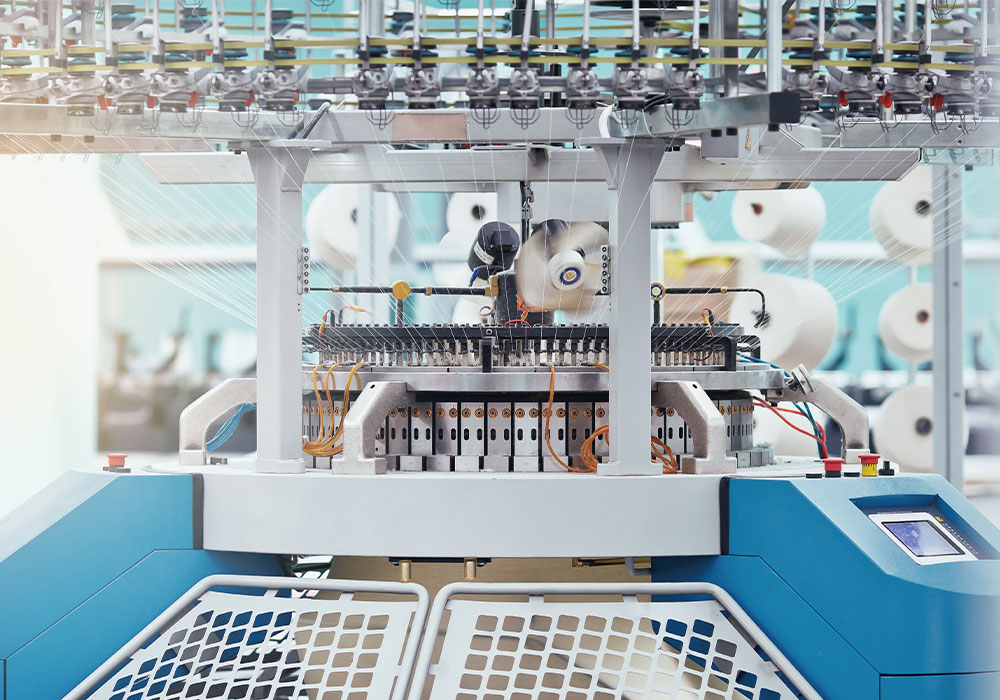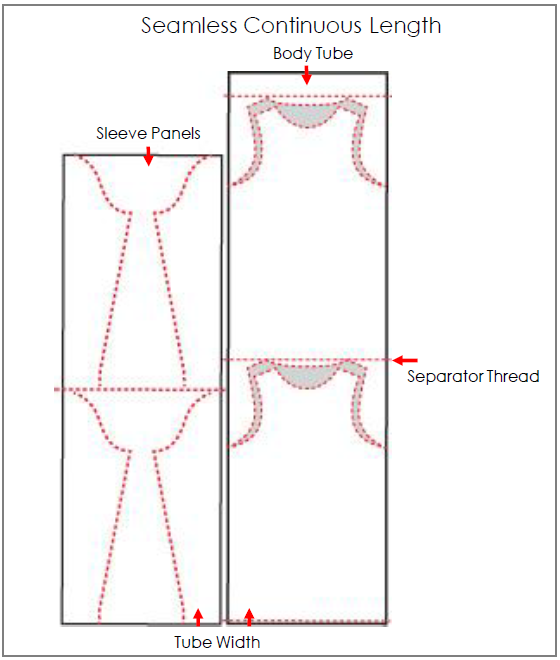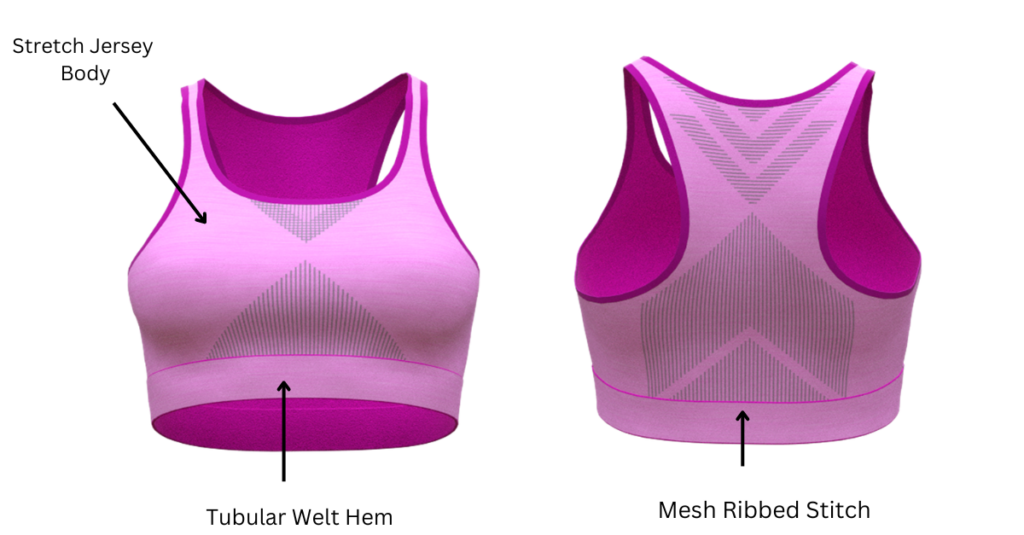Seamless and Integral Knitting
Seamless Circular Knitting
With seamless circular knitting machines, designers can produce whole garment pieces with minimal sewing production steps. These machines have the capability to knit garment pieces to length or knit continuous tubing, which includes all the pattern panels with minimal sewing assembly. Seamless circular knitting machines use smaller, body-sized cylinders, which minimize the size ranges for production, but garments from these machines usually include stretch yarns to accommodate flexible sizing.
The type of knitting machine will determine the technical capabilities of the garments. Seamless circular knitting machines come in single and double knit options.

A seamless circular knitting machine
Body mapping, a technique for placing multiple stitch structures on the same pattern, is popular with this knitting technology for creating garments with specific performance zones built in. The seamless knitting technology eliminates the need for side seams, which reduces chafing on form-fitting garments and results in smoother fits. These attributes make it a popular knit production choice for hosiery, socks, activewear, and body-shaping undergarments.
Garment Knitted Length
In one method of seamless circular production, the garment is knit to length with start and finishing welts. The knitted tube has markings for the cut lines. There is a minimal amount of sewing needed for specific types of garment in production. Since these garments are knitted in tubes, there are drawbacks in fitting and shaping. This can be resolved by changing stitch structures or utilizing different elastic yarns to create different tension zones.
Seamless Continuous Length

Sizing for continuous-length knitting is determined by the cylinder size. Panels are knitted continuously with a separator thread to segment between panels.
With seamless-continuous-length knitting, the panels of the garment are knitted into the fabric tubes, which can be segmented with separator threads between panels or sizes. In the illustration, you see how the tube contains both sleeves knitted continuously with separator threads, and the other tube contains the body.
Assembly of this garment would require separating the panels, cutting along the cut lines, and then assembling the garment with a cut-and-sew production process. This type of garment lacks side seams but requires finishing on the collar, armholes, and hem.
Continuous-length knitting produces garments faster than garment knitted lengths, but does require more finishing steps to assemble the final garment.
Reciprocal Knitting
Reciprocal knitting involves holding loops on a circular knitting machine to vary the number of courses within an area. This action requires that some needles not be knit during shaping. The inactive needles, coupled with the direction change of the knitting action during reciprocation, decrease the knitting speed in production. This technique can be done on specialized circular knitting machines and is used mostly for socks and hosiery.
With reciprocal knitting action, the machine can knit 3-dimensional and intarsia designs. This technique is found in some seamless bra products where different performance textures have been body-mapped into the garment and the cups of the bra have been knitted with 3-dimensional shaping.
Body Mapping
Knit structure placement, or body mapping, can improve functional aspects of the product, such as performance and comfort, by reinforcing areas of high impact, abrasion, and wear, and can improve comfort and fit for better dexterity. In the illustration, you can see how the sports bra illustration has different stitch zones. This garment is designed for seamless circular knitting with textured stitches to provide ventilation in the hot zones during exercise.

Example of a seamless sports bra design with body mapping for performance enhancement.
This technique can be achieved with a regular cut-and-sew method and multiple fabric textures. Still, the advantage of body mapping on seamless circular knitting machines is to minimize the number of seams that would cause abrasion to the wearer, especially in a form-fitting garment. Some functional benefits of body mapping in seamless knitting are a reduction of fabric and yarn waste, increased product performance, and increased comfort, fit, and movement, Aesthetic advantages include a clean garment that accentuates shape and movement through texture or color blocking.
Integral Knitting
Integral knitting refers to knitting a whole garment on one machine, including adding button-holes, pockets, collars, and hems. This results in a garment with little to no seams, produced on a flat-bed machine as opposed to a circular machine. This technology minimizes need for assembly as the garment exits the machine fully assembled. As with seamless circular garment knitted length knitting, integral knitting on flat-bed machines offers production advantages, including decreasing the amount of yarn and fabric wastage, reducing the number of finishing steps, increasing fit quality and accuracy with minimal failure at the seams, and designing to the contours of the body with coloration and knit structure. Machine productivity reduces with integral knitting and requires a higher skill level to program.
Integral knitting works on special flat-bed machines with at least three yarn carriers and four needle beds. For the most simple of styles, three yarn carriers are required as the first carries the yarn for a sleeve, the second for the body, and the third for the other sleeve. There will be at least two additional yarn carriers, one carrying a setup yarn to allow for tensioning and one carrying a separator yarn. Specialty patterns or coloration require additional carriers, and machines can have up to 20 carriers or more. Knitting all three pieces simultaneously requires four needle beds as the lower two beds knit the garment, and the upper two beds transfer the stitches. The machine knits the three separate pieces until they reach the join at the underarm; at this point, the two outer carriers are removed from the knitting zone, and the remaining carrier completes the garment from the armhole to the collar.
Body mapping with texture, color, and gauge can be produced on these machines. While production with integral knitting tends to run slower and more costly than other flat-bed production methods, it allows for the opportunity for garment manufacturing to be more in-region and more agile in response to customers’ needs.
TERMS TO KNOW (click to flip)
A knit fabric made on one set of needles.
view in glossaryThe basic unit of construction of knitted fabric, consisting of the loop of yarn formed by the needle. The stitch…
view in glossaryA knitting stitch that produces tuck or open effects by having certain needles hold more than one loop at a…
view in glossaryA yarn placed behind a knitting needle so that it does not knit or tuck. Also known as a miss…
view in glossary

